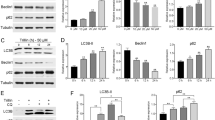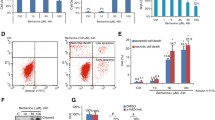Abstract
Bufalin extracts are a part of traditional Chinese medicine, Chansu. In the current study, we investigated the effect of bufalin on the proliferation of the human hepatocellular carcinoma (HCC) cell lines, Huh-7 and HepG-2, and explored the therapeutic potential of the drug. Our results demonstrated that bufalin markedly inhibited cell proliferation and promoted apoptosis in the Huh-7 and HepG-2 cells in vitro. The underlying mechanism of the bufalin-induced apoptosis was the induction of endoplasmic reticulum (ER) stress via the IRE1–JNK pathway. In addition, during the ER stress response, the autophagy pathway, characterized by the conversion of LC3-I to LC3-II, was activated, resulting in increased Beclin-1 protein levels, decreased p62 expression and stimulation of autophagic flux. Our data supported the pro-survival role of bufalin-induced autophagy when the autophagy pathway was blocked with specific chemical inhibitors; the involvement of the IRE1 pathway in the ER stress-induced autophagy was also demonstrated when the expression of IRE1 and CHOP was silenced using siRNA. These data indicate that combining bufalin with a specific autophagy inhibitor could be a promising therapeutic approach for the treatment of HCC.






Similar content being viewed by others
Abbreviations
- HCC:
-
Hepatocellular carcinoma
- DMEM:
-
Dulbecco’s modified eagle medium
- DMSO:
-
Dimethyl sulfoxide
- PI:
-
Propidium iodide
- CCK-8:
-
Cell Counting Kit-8
- SD:
-
Standard deviation
- CHOP:
-
Enhancer binding protein-homologous protein
- PARP:
-
Poly(ADP-Ribose) polymerase
- ANOVA:
-
Analysis of variance
- IRE1:
-
Inositol-requiring enzyme 1
- ATF6:
-
Activating transcription factor 6
- PERK:
-
PKR-like ER kinase
- UPR:
-
Unfolded protein response
- ASK1:
-
Apoptosis-signal-regulating kinase
- TRAF2:
-
TNF-receptor-associated factor 2
- ER:
-
Endoplasmic reticulum
References
Jemal A, Bray F, Center MM, Ferlay J, Ward E, Forman D (2011) Global cancer statistics. CA Cancer J Clin 61(2):69–90. doi:10.3322/caac.20107
Bruix J, Sherman M (2005) Management of hepatocellular carcinoma. Hepatology 42(5):1208–1236. doi:10.1002/hep.20933
Ma Y, Hendershot LM (2004) The role of the unfolded protein response in tumour development: friend or foe? Nat Rev Cancer 4(12):966–977. doi:10.1038/nrc1505
Lee AS, Hendershot LM (2006) ER stress and cancer. Cancer Biol Ther 5(7):721–722
Vaupel P, Harrison L (2004) Tumor hypoxia: causative factors, compensatory mechanisms, and cellular response. Oncologist 9(Suppl 5):4–9. doi:10.1634/theoncologist.9-90005-4
Wu J, Kaufman RJ (2006) From acute ER stress to physiological roles of the unfolded protein response. Cell Death Differ 13(3):374–384. doi:10.1038/sj.cdd.4401840
Schroder M, Kaufman RJ (2005) The mammalian unfolded protein response. Annu Rev Biochem 74:739–789. doi:10.1146/annurev.biochem.73.011303.074134
Ron D, Walter P (2007) Signal integration in the endoplasmic reticulum unfolded protein response. Nat Rev Mol Cell Biol 8(7):519–529. doi:10.1038/nrm2199
Zheng QY, Li PP, Jin FS, Yao C, Zhang GH, Zang T, Ai X (2013) Ursolic acid induces ER stress response to activate ASK1-JNK signaling and induce apoptosis in human bladder cancer T24 cells. Cell Signal 25(1):206–213. doi:10.1016/j.cellsig.2012.09.012
Kato H, Nakajima S, Saito Y, Takahashi S, Katoh R, Kitamura M (2012) mTORC1 serves ER stress-triggered apoptosis via selective activation of the IRE1-JNK pathway. Cell Death Differ 19(2):310–320. doi:10.1038/cdd.2011.98
Rubinsztein DC (2006) The roles of intracellular protein-degradation pathways in neurodegeneration. Nature 443(7113):780–786. doi:10.1038/nature05291
Ogata M, Hino S, Saito A, Morikawa K, Kondo S, Kanemoto S, Murakami T, Taniguchi M, Tanii I, Yoshinaga K, Shiosaka S, Hammarback JA, Urano F, Imaizumi K (2006) Autophagy is activated for cell survival after endoplasmic reticulum stress. Mol Cell Biol 26(24):9220–9231. doi:10.1128/MCB.01453-06
Marino G, Madeo F, Kroemer G (2011) Autophagy for tissue homeostasis and neuroprotection. Curr Opin Cell Biol 23(2):198–206. doi:10.1016/j.ceb.2010.10.001
Lum JJ, DeBerardinis RJ, Thompson CB (2005) Autophagy in metazoans: cell survival in the land of plenty. Nat Rev Mol Cell Biol 6(6):439–448. doi:10.1038/nrm1660
Shintani T, Klionsky DJ (2004) Autophagy in health and disease: a double-edged sword. Science 306(5698):990–995. doi:10.1126/science.1099993
Hayashi-Nishino M, Fujita N, Noda T, Yamaguchi A, Yoshimori T, Yamamoto A (2009) A subdomain of the endoplasmic reticulum forms a cradle for autophagosome formation. Nat Cell Biol 11(12):1433–1437. doi:10.1038/ncb1991
Yla-Anttila P, Vihinen H, Jokitalo E, Eskelinen EL (2009) 3D tomography reveals connections between the phagophore and endoplasmic reticulum. Autophagy 5(8):1180–1185
Lim SC, Hahm KS, Lee SH, Oh SH (2010) Autophagy involvement in cadmium resistance through induction of multidrug resistance-associated protein and counterbalance of endoplasmic reticulum stress WI38 lung epithelial fibroblast cells. Toxicology 276(1):18–26. doi:10.1016/j.tox.2010.06.010
Yang PM, Liu YL, Lin YC, Shun CT, Wu MS, Chen CC (2010) Inhibition of autophagy enhances anticancer effects of atorvastatin in digestive malignancies. Cancer Res 70(19):7699–7709. doi:10.1158/0008-5472.CAN-10-1626
Xu Y, Yu H, Qin H, Kang J, Yu C, Zhong J, Su J, Li H, Sun L (2012) Inhibition of autophagy enhances cisplatin cytotoxicity through endoplasmic reticulum stress in human cervical cancer cells. Cancer Lett 314(2):232–243. doi:10.1016/j.canlet.2011.09.034
Kang XH, Xu ZY, Gong YB, Wang LF, Wang ZQ, Xu L, Cao F, Liao MJ (2013) Bufalin reverses HGF-induced resistance to EGFR-TKIs in EGFR mutant lung cancer cells via blockage of Met/PI3k/Akt pathway and induction of apoptosis. Evid Based Complement Alternat Med 2013:243859. doi:10.1155/2013/243859
Hsiao YP, Yu CS, Yu CC, Yang JS, Chiang JH, Lu CC, Huang HY, Tang NY, Yang JH, Huang AC, Chung JG (2012) Triggering apoptotic death of human malignant melanoma a375.s2 cells by bufalin: involvement of caspase cascade-dependent and independent mitochondrial signaling pathways. Evid Based Complement Alternat Med 2012:591241. doi:10.1155/2012/591241
Yan S, Qu X, Xu C, Zhu Z, Zhang L, Xu L, Song N, Teng Y, Liu Y (2012) Down-regulation of Cbl-b by bufalin results in up-regulation of DR4/DR5 and sensitization of TRAIL-induced apoptosis in breast cancer cells. J Cancer Res Clin Oncol 138(8):1279–1289. doi:10.1007/s00432-012-1204-4
Tsai SC, Yang JS, Peng SF, Lu CC, Chiang JH, Chung JG, Lin MW, Lin JK, Amagaya S, Wai-Shan Chung C, Tung TT, Huang WW, Tseng MT (2012) Bufalin increases sensitivity to AKT/mTOR-induced autophagic cell death in SK-HEP-1 human hepatocellular carcinoma cells. Int J Oncol 41(4):1431–1442. doi:10.3892/ijo.2012.1579
Shi YH, Ding ZB, Zhou J, Hui B, Shi GM, Ke AW, Wang XY, Dai Z, Peng YF, Gu CY, Qiu SJ, Fan J (2011) Targeting autophagy enhances sorafenib lethality for hepatocellular carcinoma via ER stress-related apoptosis. Autophagy 7(10):1159–1172. doi:10.4161/auto.7.10.16818
Takai N, Kira N, Ishii T, Yoshida T, Nishida M, Nishida Y, Nasu K, Narahara H (2012) Bufalin, a traditional oriental medicine, induces apoptosis in human cancer cells. Asian Pac J Cancer Prev 13(1):399–402
Li D, Qu X, Hou K, Zhang Y, Dong Q, Teng Y, Zhang J, Liu Y (2009) PI3K/Akt is involved in bufalin-induced apoptosis in gastric cancer cells. Anticancer Drugs 20(1):59–64. doi:10.1097/CAD.0b013e3283160fd6
Jiang Y, Zhang Y, Luan J, Duan H, Zhang F, Yagasaki K, Zhang G (2010) Effects of bufalin on the proliferation of human lung cancer cells and its molecular mechanisms of action. Cytotechnology 62(6):573–583. doi:10.1007/s10616-010-9310-0
Boyce M, Bryant KF, Jousse C, Long K, Harding HP, Scheuner D, Kaufman RJ, Ma D, Coen DM, Ron D, Yuan J (2005) A selective inhibitor of eIF2alpha dephosphorylation protects cells from ER stress. Science 307(5711):935–939. doi:10.1126/science.1101902
Wiseman RL, Balch WE (2005) A new pharmacology–drugging stressed folding pathways. Trends Mol Med 11(8):347–350. doi:10.1016/j.molmed.2005.06.011
Thuerauf DJ, Marcinko M, Belmont PJ, Glembotski CC (2007) Effects of the isoform-specific characteristics of ATF6 alpha and ATF6 beta on endoplasmic reticulum stress response gene expression and cell viability. J Biol Chem 282(31):22865–22878. doi:10.1074/jbc.M701213200
Yokouchi M, Hiramatsu N, Hayakawa K, Kasai A, Takano Y, Yao J, Kitamura M (2007) Atypical, bidirectional regulation of cadmium-induced apoptosis via distinct signaling of unfolded protein response. Cell Death Differ 14(8):1467–1474. doi:10.1038/sj.cdd.4402154
He C, Levine B (2010) The Beclin 1 interactome. Curr Opin Cell Biol 22(2):140–149. doi:10.1016/j.ceb.2010.01.001
Zheng Q, Su H, Ranek MJ, Wang X (2011) Autophagy and p62 in cardiac proteinopathy. Circ Res 109(3):296–308. doi:10.1161/CIRCRESAHA.111.244707
Miao Q, Bi LL, Li X, Miao S, Zhang J, Zhang S, Yang Q, Xie YH, Wang SW (2013) Anticancer effects of bufalin on human hepatocellular carcinoma HepG2 Cells: roles of apoptosis and autophagy. Int J Mol Sci 14(1):1370–1382. doi:10.3390/ijms14011370
Yang Z, Luo H, Wang H, Hou H (2008) Preparative isolation of bufalin and cinobufagin from Chinese traditional medicine ChanSu. J Chromatogr Sci 46(1):81–85
Hong SH, Choi YH (2012) Bufalin induces apoptosis through activation of both the intrinsic and extrinsic pathways in human bladder cancer cells. Oncol Rep 27(1):114–120. doi:10.3892/or.2011.1451
Takai N, Ueda T, Ishii T, Kira N, Nishida M, Nishida Y, Nasu K, Narahara H (2011) Effects of bufalin on the proliferation of human choriocarcinoma cells. Int J Gynecol Cancer 21(6):1105–1109. doi:10.1097/IGC.0b013e318218730e
Dong Y, Yin S, Li J, Jiang C, Ye M, Hu H (2011) Bufadienolide compounds sensitize human breast cancer cells to TRAIL-induced apoptosis via inhibition of STAT3/Mcl-1 pathway. Apoptosis 16(4):394–403. doi:10.1007/s10495-011-0573-5
Costa BM, Yao H, Yang L, Buch S (2013) Role of endoplasmic reticulum (ER) stress in cocaine-induced microglial cell death. J Neuroimmune Pharmacol. 8(3):705–714. doi:10.1007/s11481-013-9438-8
Liu X, Wang M, Chen H, Guo Y, Ma F, Shi F, Bi Y, Li Y (2013) Hypothermia protects the brain from transient global ischemia/reperfusion by attenuating endoplasmic reticulum response-induced apoptosis through CHOP. PLoS ONE 8(1):e53431. doi:10.1371/journal.pone.0053431
Li J, Lee B, Lee AS (2006) Endoplasmic reticulum stress-induced apoptosis: multiple pathways and activation of p53-up-regulated modulator of apoptosis (PUMA) and NOXA by p53. J Biol Chem 281(11):7260–7270. doi:10.1074/jbc.M509868200
Lynch JM, Maillet M, Vanhoutte D, Schloemer A, Sargent MA, Blair NS, Lynch KA, Okada T, Aronow BJ, Osinska H, Prywes R, Lorenz JN, Mori K, Lawler J, Robbins J, Molkentin JD (2012) A thrombospondin-dependent pathway for a protective ER stress response. Cell 149(6):1257–1268. doi:10.1016/j.cell.2012.03.050
Fouillet A, Levet C, Virgone A, Robin M, Dourlen P, Rieusset J, Belaidi E, Ovize M, Touret M, Nataf S, Mollereau B (2012) ER stress inhibits neuronal death by promoting autophagy. Autophagy 8(6):915–926. doi:10.4161/auto.19716
Xu C, Bailly-Maitre B, Reed JC (2005) Endoplasmic reticulum stress: cell life and death decisions. J Clin Investig 115(10):2656–2664. doi:10.1172/JCI26373
Chen Y, Brandizzi F (2013) IRE1: ER stress sensor and cell fate executor. Trends Cell Biol. doi:10.1016/j.tcb.2013.06.005
Verma G, Datta M (2010) IL-1beta induces ER stress in a JNK dependent manner that determines cell death in human pancreatic epithelial MIA PaCa-2 cells. Apoptosis 15(7):864–876. doi:10.1007/s10495-010-0498-4
Kawakami T, Inagi R, Takano H, Sato S, Ingelfinger JR, Fujita T, Nangaku M (2009) Endoplasmic reticulum stress induces autophagy in renal proximal tubular cells. Nephrol Dial Transplant 24(9):2665–2672. doi:10.1093/ndt/gfp215
Yorimitsu T, Nair U, Yang Z, Klionsky DJ (2006) Endoplasmic reticulum stress triggers autophagy. J Biol Chem 281(40):30299–30304. doi:10.1074/jbc.M607007200
Kouroku Y, Fujita E, Tanida I, Ueno T, Isoai A, Kumagai H, Ogawa S, Kaufman RJ, Kominami E, Momoi T (2007) ER stress (PERK/eIF2alpha phosphorylation) mediates the polyglutamine-induced LC3 conversion, an essential step for autophagy formation. Cell Death Differ 14(2):230–239
Gupta S, Deepti A, Deegan S, Lisbona F, Hetz C, Samali A (2010) HSP72 protects cells from ER stress-induced apoptosis via enhancement of IRE1alpha-XBP1 signaling through a physical interaction. PLoS Biol 8(7):e1000410. doi:10.1371/journal.pbio.1000410
Xie CM, Chan WY, Yu S, Zhao J, Cheng CH (2011) Bufalin induces autophagy-mediated cell death in human colon cancer cells through reactive oxygen species generation and JNK activation. Free Radical Biol Med 51(7):1365–1375. doi:10.1016/j.freeradbiomed.2011.06.016
Ni HM, Bockus A, Boggess N, Jaeschke H, Ding WX (2012) Activation of autophagy protects against acetaminophen-induced hepatotoxicity. Hepatology 55(1):222–232. doi:10.1002/hep.24690
Bernales S, McDonald KL, Walter P (2006) Autophagy counterbalances endoplasmic reticulum expansion during the unfolded protein response. PLoS Biol 4(12):e423. doi:10.1371/journal.pbio.0040423
Ren JH, He WS, Nong L, Zhu QY, Hu K, Zhang RG, Huang LL, Zhu F, Wu G (2010) Acquired cisplatin resistance in human lung adenocarcinoma cells is associated with enhanced autophagy. Cancer Biother Radiopharm 25(1):75–80. doi:10.1089/cbr.2009.0701
Author information
Authors and Affiliations
Corresponding author
Rights and permissions
About this article
Cite this article
Hu, F., Han, J., Zhai, B. et al. Blocking autophagy enhances the apoptosis effect of bufalin on human hepatocellular carcinoma cells through endoplasmic reticulum stress and JNK activation. Apoptosis 19, 210–223 (2014). https://doi.org/10.1007/s10495-013-0914-7
Published:
Issue Date:
DOI: https://doi.org/10.1007/s10495-013-0914-7




